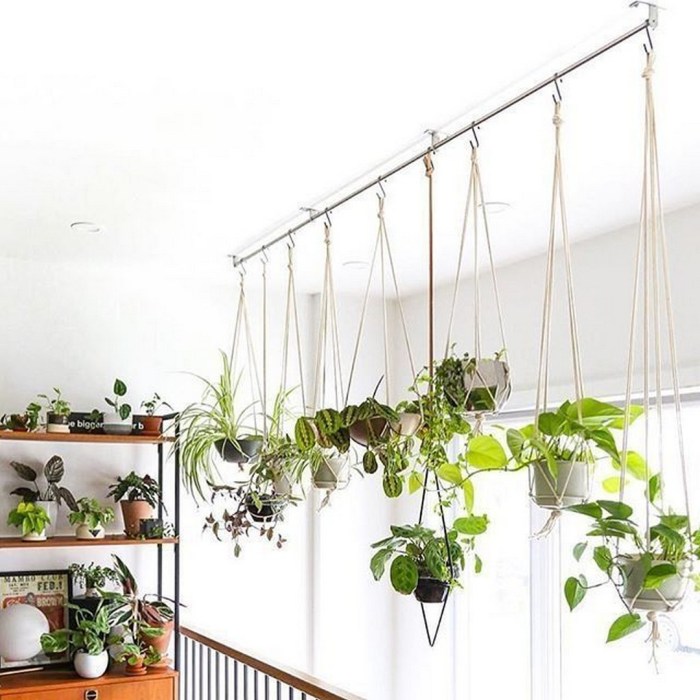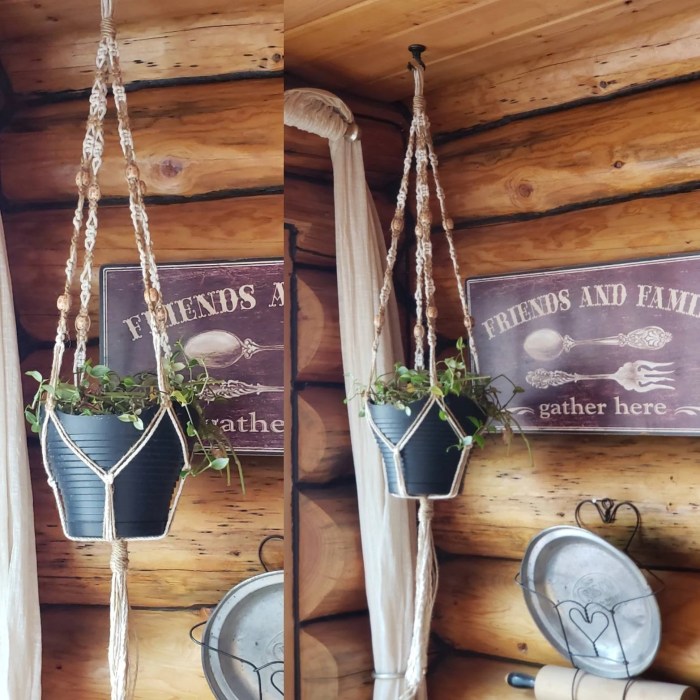Welcome to the Hanging Plants Corner, where lush greenery meets creativity! Embark on a journey to explore the captivating world of hanging plants, their unique characteristics, and their ability to transform any space into a botanical oasis.
From cascading ferns to trailing succulents, hanging plants offer a versatile and visually stunning way to add life to your home or garden. Whether you’re a seasoned plant enthusiast or just starting your green thumb adventure, this comprehensive guide will provide you with all the essential knowledge and inspiration you need to create thriving hanging plant displays.
Hanging Plant Types
Hanging plants, with their trailing vines and lush foliage, add a touch of greenery and a cascading charm to any indoor space. From the classic pothos to the exotic string of pearls, there’s a hanging plant to suit every taste and decor.
Popular Hanging Plant Varieties
Some of the most popular hanging plant varieties include:
- Pothos (Epipremnum aureum) : Known for its heart-shaped leaves and easy care, pothos is a versatile hanging plant that thrives in both bright and low light.
- String of Pearls (Senecio rowleyanus) : This unique plant features long, trailing stems adorned with plump, bead-like leaves. It prefers bright, indirect light and well-draining soil.
- Spider Plant (Chlorophytum comosum) : Spider plants are known for their arching leaves and spiderette plantlets that dangle from the ends of the stems. They tolerate a wide range of light conditions and require minimal care.
- Burro’s Tail (Sedum morganianum) : This succulent has trailing stems with plump, fleshy leaves resembling a donkey’s tail. It prefers bright, direct light and infrequent watering.
- Trailing Jade (Crassula ovata) : A miniature version of the popular jade plant, trailing jade features small, oval leaves and a compact, cascading growth habit. It thrives in bright, indirect light and requires infrequent watering.
Hanging Plant Display Ideas

Hanging plants are a versatile and stylish way to add greenery to your home. They can be used to create a variety of looks, from lush and tropical to modern and minimalist. There are many different ways to display hanging plants, so you can find a style that suits your taste and space.
Hanging plants corners have become increasingly popular in recent years, offering a stylish and functional way to add greenery to your home. Whether you’re looking to create a lush jungle oasis or simply add a touch of nature to your living space, hanging plants are a great option.
One of the most popular ways to display hanging plants is to suspend them above windows. This allows you to enjoy the beauty of your plants while also taking advantage of natural light. For more ideas on hanging plants above windows, visit hanging plants above window . With so many different hanging plant options available, you’re sure to find the perfect ones to complement your home decor and create a beautiful and inviting hanging plants corner.
Hanging Systems
There are a variety of hanging systems available for hanging plants. Some of the most popular options include:
- Macrame hangers: Macrame hangers are a beautiful and bohemian way to hang plants. They are made from knotted cords and can be hung from the ceiling or a hook.
- Ceiling hooks: Ceiling hooks are a simple and inexpensive way to hang plants. They can be screwed into the ceiling and then used to hang a variety of plants.
- Plant stands: Plant stands are a great way to display hanging plants on the floor. They come in a variety of styles and sizes, so you can find one that fits your space and décor.
Creating Visually Appealing Arrangements
When creating a hanging plant arrangement, there are a few things to keep in mind:
- Variety: Use a variety of plants in different sizes and shapes to create a visually appealing arrangement.
- Color: Choose plants with different colors of foliage to add interest and depth to your arrangement.
- Texture: Combine plants with different textures to create a more dynamic look.
Hanging Plant Care Guide
Hanging plants add a touch of greenery and beauty to any home, but they require specific care to thrive. This comprehensive guide will provide you with all the essential information you need to keep your hanging plants healthy and vibrant.Whether
you’re a seasoned plant enthusiast or a beginner, understanding the unique needs of hanging plants is crucial. This guide covers everything from watering techniques and frequency to fertilization schedules, pruning and repotting procedures, and troubleshooting common problems. By following these tips, you can ensure that your hanging plants flourish and bring joy to your home for years to come.
Hanging plants corners are a great way to add a touch of greenery to your home. They can be used to create a variety of looks, from lush and tropical to modern and minimalist. One of the most popular ways to use hanging plants is to create a hanging plants aquarium.
This is a great way to add some life to your aquarium, and it can also help to improve the water quality. If you’re interested in learning more about hanging plants aquariums, be sure to check out this website: hanging plants aquarium . They have a wealth of information on how to create and care for a hanging plants aquarium.
Watering Techniques and Frequency
Proper watering is essential for the health of hanging plants. The frequency of watering will vary depending on the type of plant, the size of the pot, and the humidity levels in your home. Generally, it’s best to water your hanging plants when the top inch of soil feels dry to the touch.
Avoid overwatering, as this can lead to root rot. Use room-temperature water and allow the excess water to drain out of the drainage holes in the bottom of the pot.
Fertilization Schedules
Hanging plants benefit from regular fertilization to provide them with the nutrients they need to grow and thrive. Choose a balanced fertilizer that is diluted according to the manufacturer’s instructions. Fertilize your hanging plants every two to four weeks during the growing season (spring and summer).
Avoid fertilizing during the winter months when plants are dormant.
Pruning and Repotting Procedures
Pruning and repotting are essential tasks for maintaining the health and appearance of hanging plants. Pruning helps to remove dead or damaged leaves and stems, encourages new growth, and keeps plants within bounds. Repotting is necessary when plants become rootbound or when the potting mix has become depleted of nutrients.
When repotting, use a fresh, well-draining potting mix and a pot that is only slightly larger than the previous one.
Troubleshooting Common Problems
Even with proper care, hanging plants can sometimes experience problems. Common issues include yellowing leaves, brown tips on leaves, and pests. Yellowing leaves can indicate overwatering, underwatering, or nutrient deficiency. Brown tips on leaves can be caused by underwatering, low humidity, or exposure to cold drafts.
Pests such as aphids, mealybugs, and spider mites can also affect hanging plants. If you notice any problems with your hanging plants, it’s important to identify the cause and take appropriate action to address the issue.By following the tips Artikeld in this guide, you can ensure that your hanging plants remain healthy and vibrant for years to come.
Remember to provide them with the right amount of water, fertilizer, and sunlight, and to prune and repot them as needed. With proper care, your hanging plants will bring beauty and joy to your home for many years to come.
Benefits of Hanging Plants
Incorporating hanging plants into interior and exterior spaces offers numerous benefits that enhance well-being and aesthetics. Scientific evidence supports the positive impact of hanging plants on air quality, stress reduction, and overall ambiance.
Air Quality Improvement
Hanging plants act as natural air purifiers, effectively removing harmful toxins and pollutants from the air. Studies have shown that certain plant species, such as spider plants and peace lilies, are particularly effective in absorbing formaldehyde, benzene, and trichloroethylene.
Stress Reduction and Enhanced Mood
Research has demonstrated that interacting with plants can significantly reduce stress levels. The presence of hanging plants in a room has been linked to lower blood pressure, decreased heart rate, and improved mood. The calming effect of plants is attributed to their ability to evoke a sense of tranquility and connection with nature.
Hanging plants are a beautiful and easy way to add life to your home, and they can be a great way to create a relaxing and inviting atmosphere. If you’re looking for a low-maintenance way to enjoy the benefits of hanging plants, consider investing in bunnings self watering hanging pots . These pots are designed to water your plants automatically, so you can enjoy your plants without having to worry about watering them regularly.
This can be a great option for busy people or those who travel frequently. With a hanging plants corner featuring bunnings self watering hanging pots, you can enjoy the beauty of hanging plants without the hassle.
Aesthetic Enhancement, Hanging plants corner
Hanging plants add a touch of elegance and vibrancy to any space. They bring a sense of life and freshness, creating a more inviting and visually appealing environment. The cascading foliage and lush greenery of hanging plants can transform a dull corner into a captivating focal point.
DIY Hanging Plant Projects: Hanging Plants Corner

With the growing popularity of indoor gardening, hanging plants have become a stylish and practical way to add greenery to your home. Not only do they save space, but they also create a sense of airiness and tranquility. If you’re looking for a unique way to display your plants, why not try making your own macrame hanging planter?Macrame is a form of knotting that has been used for centuries to create everything from hammocks to plant hangers.
It’s a relatively simple technique to learn, and it’s a great way to add a personal touch to your home décor.
Macrame Hanging Planter Tutorial
To make a macrame hanging planter, you will need the following materials:* Macrame cord (available at most craft stores)
- Scissors
- Measuring tape
- Plant hanger ring
- Potted plant
Once you have gathered your materials, you can follow these step-by-step instructions to create your own macrame hanging planter:
- Cut four pieces of macrame cord, each approximately 10 feet long.
- Fold the cords in half and tie them to the plant hanger ring, using a lark’s head knot.
- Divide the cords into two groups of two.
- Tie a square knot with the first two cords on the left.
- Tie a square knot with the first two cords on the right.
- Repeat steps 4 and 5 until the planter is the desired length.
- To finish the planter, tie a gathering knot at the bottom of the cords.
- Insert the potted plant into the planter.
You can customize your macrame hanging planter by using different colors of macrame cord or by adding beads or other embellishments. You can also experiment with different knotting techniques to create a unique design.
Concluding Remarks

As you venture into the world of hanging plants, remember that they are not just decorative elements but living organisms that bring countless benefits to your well-being. Embrace the joy of nurturing these botanical wonders and enjoy the beauty and tranquility they bring to your surroundings.
Helpful Answers
What are the most popular hanging plant varieties?
Some of the most popular hanging plant varieties include pothos, spider plants, ferns, succulents, and trailing begonias.
How do I choose the right hanging plant for my space?
Consider factors such as the amount of light available, the size of the space, and the desired aesthetic when selecting hanging plants.
How often should I water my hanging plants?
Watering frequency will vary depending on the type of plant, but a good rule of thumb is to water when the soil feels dry to the touch.